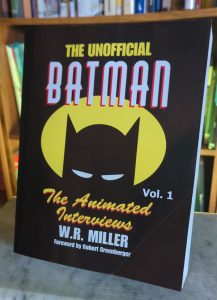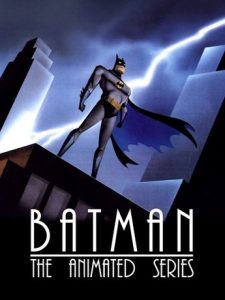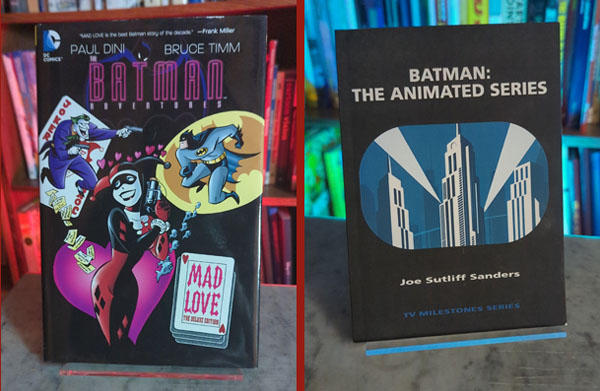


Welcome to the Cartoon Research Card Catalog – your monthly check-in on present publications, periodicals, and peeks at important books from today and throughout the last century of animation!

When Batman: The Animated Series debuted in 1992, who could have predicted that the storytelling and characters contained within would echo across animation, comics and films for the next three decades? It’s an understatement to say that Batman: The Animated Series was monumental in showing that audiences were receptive to Batman-centric stories that contained a more serious tone; characters and storylines that contained drama, suspense, and emotion not normally explored through Saturday mornings. Thanks to author, W.R. Miller (The Animated Voice: Interviews with Voice Actors and contributor to The Animated Movie Guide, The Hanna-Barbera Treasury, Animato!, and much, much more) and publisher BearManor Media have compiled and published a five volume set of interviews with almost every single contributor responsible for making the show happen. Batman: The Animated Interviews Volumes 1-5 were originally released November 15th, 2024 in hardcover with rereleases in paperback starting this past January, 2025 – with each volume releasing once per month until Volume 5’s release this upcoming June. I’ve spent the last two weeks chewing through the 800+ page Volume One and – if these volumes are not already on your radar – then let me say upfront and with emphasis that this first volume is an absolute joy to read.
 Author W.R. Miller has set up this first volume to explore how Batman: The Animated Series (B:TAS) came to be through interviews conducted by the author from the early 1990’s during production and from new interviews spanning from 2019-2022. Additionally, there are relevant sourced interviews from other groups and individuals, especially when a production member has since passed away, sprinkled throughout the volume. Noted comic editor and writer, Robert Greenberger, opens with an introduction detailing various events, big and small, that had to occur for a series like B:TAS to even have a shot at being made. Through the next 66 interviews we see a combination of a clear vision, passionate crew, a badass demo reel, and corporate faith in untested young artists paired with experienced producers, to create a timeless series.
Author W.R. Miller has set up this first volume to explore how Batman: The Animated Series (B:TAS) came to be through interviews conducted by the author from the early 1990’s during production and from new interviews spanning from 2019-2022. Additionally, there are relevant sourced interviews from other groups and individuals, especially when a production member has since passed away, sprinkled throughout the volume. Noted comic editor and writer, Robert Greenberger, opens with an introduction detailing various events, big and small, that had to occur for a series like B:TAS to even have a shot at being made. Through the next 66 interviews we see a combination of a clear vision, passionate crew, a badass demo reel, and corporate faith in untested young artists paired with experienced producers, to create a timeless series.
Each interview features a biography of each subject and a quick explanation of their roles in making B:TAS. No relationship is left unexamined; whether the relationship was between the production staff – writers, storyboard artists, background designers, voice directors, orchestra composers and directors – rights and stakeholders like corporate entities Warner Brothers and DC Comics, broadcast networks like Fox Kids, discussions with Broadcast Standards and Practices – Miller even features a fascinating interview with Michael Uslan whose work in bringing the Tim Burton 1989 live action Batman film was pivotal for Warner Bros. to consider embarking on a Batman animated series. Personal highlights include interviews with VP of Fox Kids, Sidney Iwanter, Eric Radomski the Swiss army knife, an interview with Bruce Timm from the 1990s, voice director Andrea Romano, and Executive/Producer, Margaret Loesch.
 Miller’s background as a layout and storyboard artist, with credits including The Simpsons, Scooby-Doo and the Cyber Chase, Courage the Cowardly Dog and 101 Dalmatians: The Series, in addition to early work as a journalist on periodicals like Animation Magazine and Animato!, have given Miller the insight to ask pointed, relevant, and open ended questions that allow the interviewee to reminisce and recount fascinating stories. Miller pushes for further explanations when necessary and does a great job making subjects feel heard while getting them past rudimentary information and into their unique experiences, perceptions and meanings. Miller even sources forum posts and blog posts – a really smart way to archive already disappearing digital conversations and statements.
Miller’s background as a layout and storyboard artist, with credits including The Simpsons, Scooby-Doo and the Cyber Chase, Courage the Cowardly Dog and 101 Dalmatians: The Series, in addition to early work as a journalist on periodicals like Animation Magazine and Animato!, have given Miller the insight to ask pointed, relevant, and open ended questions that allow the interviewee to reminisce and recount fascinating stories. Miller pushes for further explanations when necessary and does a great job making subjects feel heard while getting them past rudimentary information and into their unique experiences, perceptions and meanings. Miller even sources forum posts and blog posts – a really smart way to archive already disappearing digital conversations and statements.
That’s not to say the book is perfect. It is obvious that the text featured in this book was derived from an ebook with occasional hyperlinks printed – I touched them with my finger, but they wouldn’t open up, unfortunately. I do hope BearManor Media considers a fresh layout with smaller font size for a shorter second edition as the sheer length has resulted in a fairly high price. Hardcovers of each volume hover around $110 and each paperback hovers around $60. That’s not to say that this set isn’t worth those prices, they are, it would just be nice to see a more affordable option.
Batman: The Animated Interviews Volume 1 is an essential collection of interviews documenting the origins of a milestone series whose reverberations can still be felt 33 years later. The serendipitous right place and right time of W.R. Miller as a journalist in the 90’s, in addition to an inconvenient world health crisis in 2020, has produced a thorough historical record that sheds light on a pivotal industrial change for animation production, a snapshot of growth in audiences tastes, and shines a spotlight on those responsible for redefining the Dark Detective’s stories for an entirely new generation of comic and animation lovers. Highly Recommended.

Once you’ve filled up on the historical context of the production of the show you may want to check out Paul Dini and Bruce Timm’s Mad Love, a one-shot comic book released in 1994 during the production of Batman: The Animated Series and briefly talked about throughout The Animated Interviews Volume 1. Mad Love explores the origins of the animated series’ original character, Harley Quinn, and her imbalanced relationship with the Joker. The pictured Deluxe Edition, released in 2015, includes an introduction penned by Dini and reproduced original sketches and color layouts by Timm with a two page introduction.
 Additionally, Joe Sutliff Sanders wrote a fascinatingly nuanced critique of B:TAS in the TV Milestones series released in 2021. Sanders explores three arguments in three chapters. First, that the tension between the art deco and subsequent streamlining art movements in the 1920s and 1930s is replicated within the themes and design of B:TAS. Sanders next argues that B:TAS has a unique exploration of how the wealthy elite in Gotham, including Bruce Wayne, find humanity. And lastly, that Harley Quinn is a character that encapsulates some of the questions and contradictions third-wave feminism in the 1990s was asking and investigating. It is a well thought out series of arguments that makes you consider the implications.
Additionally, Joe Sutliff Sanders wrote a fascinatingly nuanced critique of B:TAS in the TV Milestones series released in 2021. Sanders explores three arguments in three chapters. First, that the tension between the art deco and subsequent streamlining art movements in the 1920s and 1930s is replicated within the themes and design of B:TAS. Sanders next argues that B:TAS has a unique exploration of how the wealthy elite in Gotham, including Bruce Wayne, find humanity. And lastly, that Harley Quinn is a character that encapsulates some of the questions and contradictions third-wave feminism in the 1990s was asking and investigating. It is a well thought out series of arguments that makes you consider the implications.
If that’s still not enough Batman: The Animated Series, make sure to check out another behind-the-scenes peek at the production art of the series in the rare hardcover, Batman Animated by Paul Dini and Chip Kidd and released in 1998.